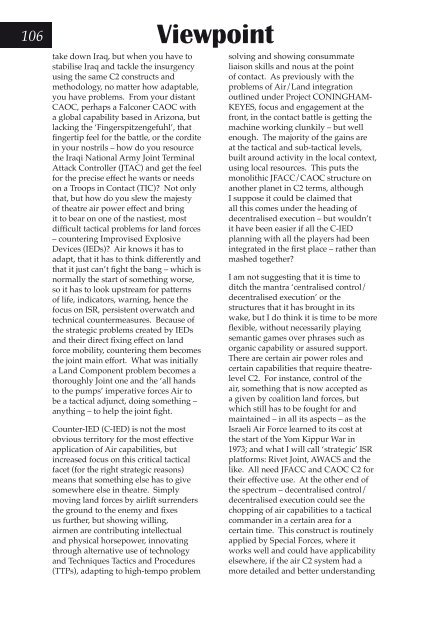REVIEW - Royal Air Force Centre for Air Power Studies
REVIEW - Royal Air Force Centre for Air Power Studies
REVIEW - Royal Air Force Centre for Air Power Studies
You also want an ePaper? Increase the reach of your titles
YUMPU automatically turns print PDFs into web optimized ePapers that Google loves.
106<br />
take down Iraq, but when you have to<br />
stabilise Iraq and tackle the insurgency<br />
using the same C2 constructs and<br />
methodology, no matter how adaptable,<br />
you have problems. From your distant<br />
CAOC, perhaps a Falconer CAOC with<br />
a global capability based in Arizona, but<br />
lacking the ‘Fingerspitzengefuhl’, that<br />
fingertip feel <strong>for</strong> the battle, or the cordite<br />
in your nostrils – how do you resource<br />
the Iraqi National Army Joint Terminal<br />
Attack Controller (JTAC) and get the feel<br />
<strong>for</strong> the precise effect he wants or needs<br />
on a Troops in Contact (TIC)? Not only<br />
that, but how do you slew the majesty<br />
of theatre air power effect and bring<br />
it to bear on one of the nastiest, most<br />
difficult tactical problems <strong>for</strong> land <strong>for</strong>ces<br />
– countering Improvised Explosive<br />
Devices (IEDs)? <strong>Air</strong> knows it has to<br />
adapt, that it has to think differently and<br />
that it just can’t fight the bang – which is<br />
normally the start of something worse,<br />
so it has to look upstream <strong>for</strong> patterns<br />
of life, indicators, warning, hence the<br />
focus on ISR, persistent overwatch and<br />
technical countermeasures. Because of<br />
the strategic problems created by IEDs<br />
and their direct fixing effect on land<br />
<strong>for</strong>ce mobility, countering them becomes<br />
the joint main ef<strong>for</strong>t. What was initially<br />
a Land Component problem becomes a<br />
thoroughly Joint one and the ‘all hands<br />
to the pumps’ imperative <strong>for</strong>ces <strong>Air</strong> to<br />
be a tactical adjunct, doing something –<br />
anything – to help the joint fight.<br />
Counter-IED (C-IED) is not the most<br />
obvious territory <strong>for</strong> the most effective<br />
application of <strong>Air</strong> capabilities, but<br />
increased focus on this critical tactical<br />
facet (<strong>for</strong> the right strategic reasons)<br />
means that something else has to give<br />
somewhere else in theatre. Simply<br />
moving land <strong>for</strong>ces by airlift surrenders<br />
the ground to the enemy and fixes<br />
us further, but showing willing,<br />
airmen are contributing intellectual<br />
and physical horsepower, innovating<br />
through alternative use of technology<br />
and Techniques Tactics and Procedures<br />
(TTPs), adapting to high-tempo problem<br />
Viewpoint<br />
solving and showing consummate<br />
liaison skills and nous at the point<br />
of contact. As previously with the<br />
problems of <strong>Air</strong>/Land integration<br />
outlined under Project CONINGHAM-<br />
KEYES, focus and engagement at the<br />
front, in the contact battle is getting the<br />
machine working clunkily – but well<br />
enough. The majority of the gains are<br />
at the tactical and sub-tactical levels,<br />
built around activity in the local context,<br />
using local resources. This puts the<br />
monolithic JFACC/CAOC structure on<br />
another planet in C2 terms, although<br />
I suppose it could be claimed that<br />
all this comes under the heading of<br />
decentralised execution – but wouldn’t<br />
it have been easier if all the C-IED<br />
planning with all the players had been<br />
integrated in the first place – rather than<br />
mashed together?<br />
I am not suggesting that it is time to<br />
ditch the mantra ‘centralised control/<br />
decentralised execution’ or the<br />
structures that it has brought in its<br />
wake, but I do think it is time to be more<br />
flexible, without necessarily playing<br />
semantic games over phrases such as<br />
organic capability or assured support.<br />
There are certain air power roles and<br />
certain capabilities that require theatrelevel<br />
C2. For instance, control of the<br />
air, something that is now accepted as<br />
a given by coalition land <strong>for</strong>ces, but<br />
which still has to be fought <strong>for</strong> and<br />
maintained – in all its aspects – as the<br />
Israeli <strong>Air</strong> <strong>Force</strong> learned to its cost at<br />
the start of the Yom Kippur War in<br />
1973; and what I will call ‘strategic’ ISR<br />
plat<strong>for</strong>ms: Rivet Joint, AWACS and the<br />
like. All need JFACC and CAOC C2 <strong>for</strong><br />
their effective use. At the other end of<br />
the spectrum – decentralised control/<br />
decentralised execution could see the<br />
chopping of air capabilities to a tactical<br />
commander in a certain area <strong>for</strong> a<br />
certain time. This construct is routinely<br />
applied by Special <strong>Force</strong>s, where it<br />
works well and could have applicability<br />
elsewhere, if the air C2 system had a<br />
more detailed and better understanding

















